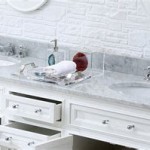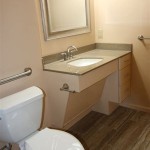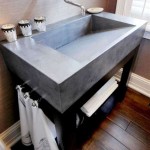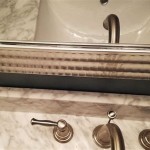How to Keep the Area Around Your Bathroom Sink Dryer
A wet bathroom sink area is a breeding ground for mold and mildew, making it essential to maintain a dry environment. A damp sink area not only looks unsightly but can also pose health risks. Fortunately, with a few simple strategies and consistent effort, you can effectively combat moisture and keep your bathroom sink area dry and hygienic.
1. Address the Source of Moisture
The first step to keeping the area around your bathroom sink dry is to identify and address the source of moisture. This might involve several factors:
- Leaky Faucets: A dripping faucet can contribute significantly to moisture build-up. Inspect your faucet for any leaks and repair them promptly.
- Splashing Water: Excessive splashing when washing your hands or face can lead to a wet countertop and surrounding areas. Be mindful of your hand movements and use a splatter guard or towel to minimize splashing.
- Poor Ventilation: Insufficient ventilation allows moisture to linger, creating a damp environment. Ensure your bathroom has an exhaust fan and that it is used effectively, especially during and after showers or baths.
- Steam from Showers/Baths: Steam from showers or baths can contribute to condensation and moisture build-up on surfaces. Consider leaving a window open for a few minutes after showering or bathing to allow steam to escape.
2. Implement Drying Strategies
Once you've addressed the source of moisture, implement these drying strategies to maintain a dry bathroom sink area:
- Towel Dry: After washing your hands or face, thoroughly dry the sink and surrounding area using a clean towel.
- Use a Squeegee: Invest in a squeegee and use it to wipe down the mirror and walls after showering or bathing. This helps to remove condensation and prevent water droplets from accumulating.
- Air Dry: If possible, leave the bathroom door or window open for a short amount of time after showering or bathing to allow air to circulate and help dry the area.
- Utilize a Dehumidifier: In humid environments, consider using a small dehumidifier in the bathroom to remove moisture from the air.
3. Maintain a Clean and Organized Space
A clean and organized bathroom sink area promotes dryness and discourages moisture build-up. Here's how to maintain a clean and organized environment:
- Regular Cleaning: Regularly clean your bathroom sink, countertop, and surrounding surfaces with a disinfectant cleaner to remove bacteria and prevent mold and mildew growth.
- Organize Essentials: Keep essential items, such as soap, toothpaste, and brushes, organized and stored neatly on the countertop or in drawers to avoid clutter and create a drier environment.
- Wipe Down Spills: Immediately wipe up any spills or drips to prevent moisture from seeping into surrounding surfaces.
By following these simple tips and practices, you can effectively combat moisture and keep the area around your bathroom sink dry, creating a more hygienic and appealing environment. Remember, consistent effort and attention to detail are key to maintaining a dry and healthy bathroom.

Kitchen Faucet Sink Splash Guard Silicone Water Catcher Mat Draining Pad Behind Grey Rubber Drying For Bathroom Countertop Protect Com

How To Declutter Your Bathroom Sink Counter Make It A Daily Habit

Silicone Drain Mat Kitchen Faucet Sink Splash Guard Water Catcher Draining Pad Behind Rubber Drying For Bathroom Countertop Protect Supplies Accessories

Silicone Faucet Mat For Kitchen Sink Splash Guard Draining Pad Drying

Kitchen Faucet Sink Splash Guard Silicone Water Catcher Mat Draining Pad Behind Drying For Bathroom Countertop Protect Com

Silicone Faucet Mat For Kitchen Bathroom Keep Drying Sink Splash Guard

How To Properly Integrate A Laundry Area In Bathroom

Kitchen Faucet Sink Splash Guard Silicone Water Catcher Mat Draining Pad Behind Grey Rubber Drying For Bathroom Countertop Protect Temu

The 5 Best Dish Racks Of 2024 Reviews By Wirecutter

Organizing The Kitchen Sink Area Polished Habitat







